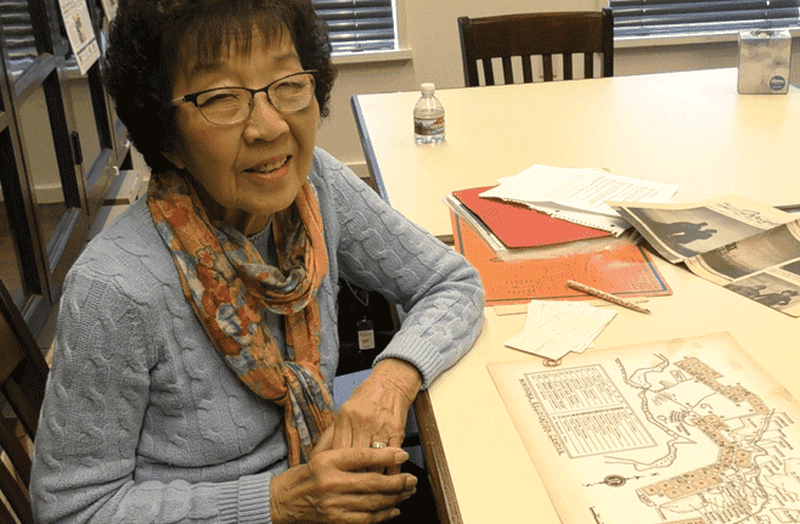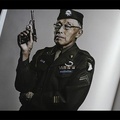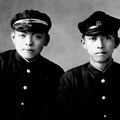At the theater of the Wing Luke Museum, which preserves the history of Asian immigrants, Irene Mano talks about her family's immigration history and life in a wartime internment camp. About 30 students from a Jewish school listened intently to her story, which also appears in Ken Mochizuki's book "Minidoka Memoirs: The Untold Story from the Yoshito Fujii Files," a record of Irene's family's wartime life in an internment camp. The elementary school students asked endless questions, such as "What did you eat in the internment camp?" and "How did you earn the money you needed to live?"
The 1920s, when Irene's parents immigrated from Hiroshima, was also a time when the Japanese community experienced great economic prosperity, thanks to the success of the first generation of Japanese immigrants in agriculture and self-employment. In 1930, Seattle was home to a peak of 8,500 Japanese people, making it the second largest Japanese population in North America after Los Angeles. At the time, about 75% of the vendors at Seattle's iconic Pike Place Market were Japanese.
However, as relations between the United States and Japan began to look bleak during the Great Depression of 1929 and the Second Sino-Japanese War, the Japanese community found itself in a difficult position. Irene says that discrimination against Japanese people before the war was severe.
"Before the war, there was much more discrimination against Asians than there was after the war. Just because we looked different from European immigrants, there were no jobs, we couldn't own land, we had to live in certain areas, and it was dangerous to go out after 8 p.m."
It was under these circumstances that the attack on Pearl Harbor occurred in 1941. The FBI began arresting Japanese people living in the United States one after another on suspicion of espionage. Eileen recounts the following in her "Minicoka Memoirs."
"Today this person was taken, today that person was taken, and it felt like we were living in a living hell."
In February 1942, the internment order was issued for all Japanese and their descendants, and Japanese people living in the United States were ordered to pack up their belongings and head to internment camps within 10 days. The internment order was not only for Japanese living in the United States, but also for their descendants who had American citizenship, and the number of internment camps reached 120,000.
"We were only allowed to take one suitcase per person to the camp. We packed the things we needed to live. Clothes, of course, but also dishes and other things. We thought we would need them."
Ten internment camps were established across the U.S., and Irene and her family were sent to the Minidoka internment camp in Idaho. With their belongings, they boarded an old train without knowing where they were going or when they would be able to return, and spent two days and a night there in fear and anxiety.
"The U.S. government said it was to 'protect' Japanese Americans from such severe discrimination. But in reality, I think one of the reasons they were incarcerated was because Japanese Americans were too prosperous through agriculture and self-employment."
"Because I was still young, it didn't affect me much, but I think it was very cruel to first-generation Japanese like my parents. All the land and property that they had worked so hard to build up after immigrating was taken away from them. My parents were very angry, but they put up with it without complaining, just like any other Japanese person who works hard without complaining."
Despite the harsh conditions of the camp, which was built in isolation in the desert under the scorching summer sun, it soon became another "Japan Town" where only Japanese people lived and Japanese customs remained. Food such as potatoes and beans was rationed, but many Japanese people actively participated in self-government, drawing new water around the camp and cultivating many fields, gardeners creating Japanese gardens, and carpenters making furniture. There we could see Japanese people accepting reality and trying to somehow carve out a life for themselves.
I wonder how Irene felt while living in the camp.
"My parents are Japanese, but I'm an American who was born and raised in the US. It felt strange to be detained and I had no privacy, but I gradually began to accept the reality."
A neighborhood association was set up in each block of the camp to facilitate communication between the American government and the residents. Irene's father was bilingual in both Japanese and English and was involved as a director of the neighborhood association, but he faced many problems. In particular, when young second-generation Japanese Americans had to be drafted into the American military, residents criticized him, and at one point a tombstone with her father's name engraved on it was placed near their house.
"They had already lost all their possessions, so why should they lose their children to a country that had taken them away? Most of the second generation troops did not survive."
The Second World War, as experienced by Japanese immigrants. It was a completely new history for me to learn about. It was completely different from the war history I learned in Japan. I wonder how much fear and hardship the first generation of Japanese and their descendants experienced. I can only imagine, but there is a reality to the stories I hear as I sit next to Irene. When looking back on the 150-year history of Japanese immigration, we cannot overlook the history of the Second World War. Tracing the path of Japanese immigrants makes me feel a strong connection as a Japanese person, and at the same time, I feel a desire to pass on their memories.
*This article is reprinted from the North American Newspaper (June 11, 2018).
© 2018 Minami Hasegawa / North American Popst






